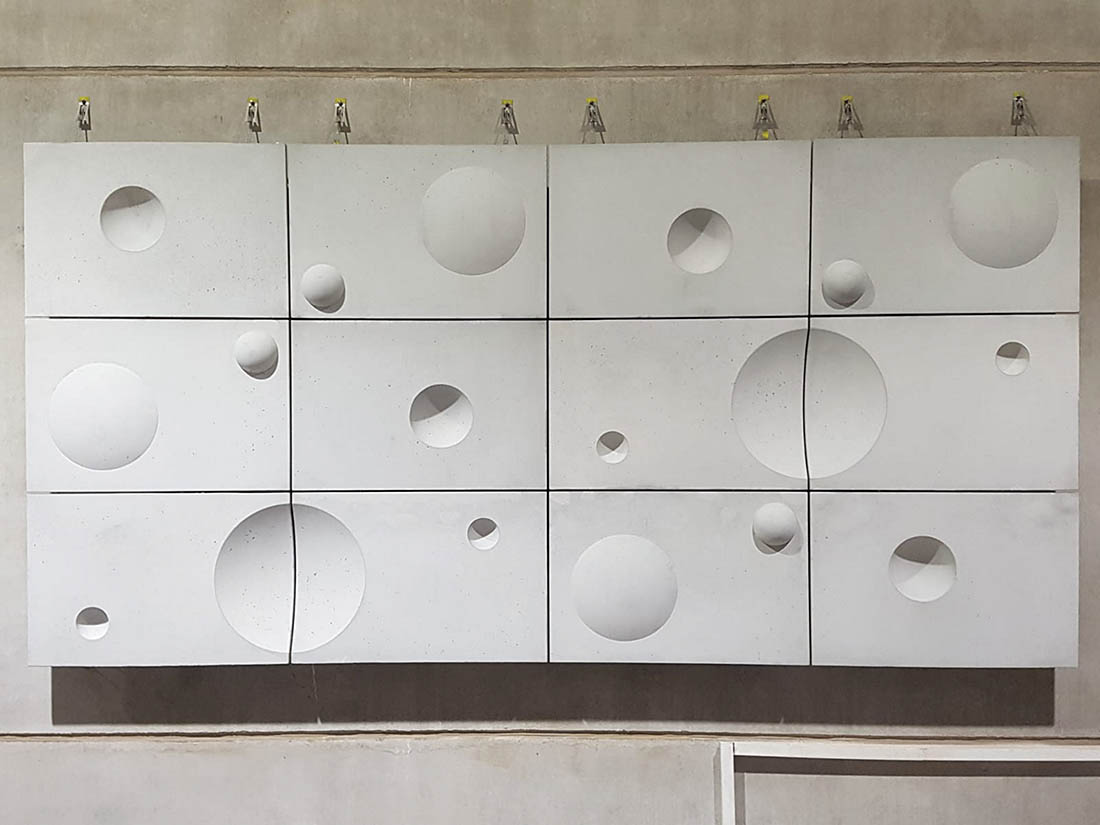Concrete can be reinforced in many ways. The most widely used and probably best known is steel-reinforced concrete, in which steel is formed into grids and encased in concrete. It is also possible to reinforce concrete with plain fibers, which are added to the concrete by simple mixing. The following considers technology to reinforce the concrete with textile grids made of continuous glass or carbon fibers laid in longitudinal and transverse directions and impregnated with polymers. These grids are then taken as reinforcement and poured into concrete – i.e., textile reinforced concrete (TRC).
Performance benefits
Reinforcing concrete with carbon or glass fiber grids offers many improvements over using steel. The fiber material is stronger and more durable in the environment – the tensile strength is two-to-six times higher than that of steel, yet the fiber’s density is only one-third to one-fifth compared to steel. Meanwhile, resistance to corrosion improves durability and allows concrete savings of up to 80%.
These advantages make the product considerably lighter in direct comparison to steel-reinforced concrete. The realization of the above advantages is also reflected in the market situation. Based on a project study performed at Institut für Textiltechnik of RWTH Aachen University – 84 projects have been completed with TRC in Germany from 2003 to 2019 – and there is also a clear upward trend in the number of projects using textile-reinforced concrete. For example, while in 2003 only 250 tonnes of TRC were used per project, this has grown to 1,200 tonnes per project.
Selection factors
The three decisive selection criteria for the application of textile reinforcements are cost, formability, and the strength of the material. TRC can be applied in many ways, due to its lightweight characteristics and form flexibility. Common examples are simple two-dimensional concrete slabs for building facades on buildings, three-dimensional concrete parts used in restoration or structural components or complex shell structures for architectural projects.
The costs during production arise largely from the value chain at the textile producer and the concrete producer. The first step in the value chain is performed by the textile supplier, who controls the textile production and impregnation of the finished textile.
Many different types of textiles are suitable for use as reinforcement. The current standard is a two-dimensional biaxial warp-knitted textile in which the warp and weft threads are connected by a knitted thread. Different stitching techniques, such as the pillar stitch or tricot stitch, influence the manufacturing costs, processing possibilities and material properties. Another textile type used is based on two-dimensional leno weaves, which are mostly used for extremely thin elements (approx. < 20 mm). One application example for this textile type is mortar grids. Leno weaving differs from the warp-knitting technology in that the warp threads are simply twisted around the weft threads to fix them.
Future production technologies for TRC therefore include improved formability and weldability of reinforcements, which can improve the handling as well as a product-specific design.
Subsequently, impregnation of the textiles is performed at the textile producer in a second step of the value chain. Impregnation usually consists of synthetic polymers, for example styrene-butadiene rubber or epoxy resin. Impregnation has become a standard for reinforcement textiles, because the bond strength of the reinforcement is significantly increased by activating all fibers by a deep penetration. So, the impregnation material is responsible for the connection of the fibers within the individual fiber strands, while the concrete matrix is responsible for the external connection of the fiber strand to the concrete. However, impregnation often causes the textile to lose its formability due to the subsequent stiffness. Therefore, in practice, not every textile reinforcement can be applied in each application. The geometry and the loads affecting the planned component significantly influence the choice of materials.
In the production of simple two-dimensional and complex three-dimensional structures, two different routes have therefore been established. While production of complex elements remains much more expensive. A simple two-dimensional panel of impregnated textile can be ordered by the concrete producer on roll or as pre-cut grid and cut individually on-site. For three-dimensional textile products, the impregnated grid either has to be preformed at the textiles producer directly after impregnation and cured, or it must be impregnated manually at the concrete producer, and both methods do have the drawback of high transport costs.
Future production technologies for TRC therefore include improved formability and weldability of reinforcements, which can improve the handling as well as a product-specific design. Another research field is automation and robot-assisted production for TRC. The realization of load path-compatible reinforcement constructions could, among other things, result in the reduction of required reinforcement material to significantly reduce production costs.
This Tech Spotlight is based on a recent VDMA Webtalk, presented by ITA – Institut für Textiltechnik, RWTH Aachen University. To register for upcoming Webtalks and view the archive of presentation, visit industryarena.com/m4t.


